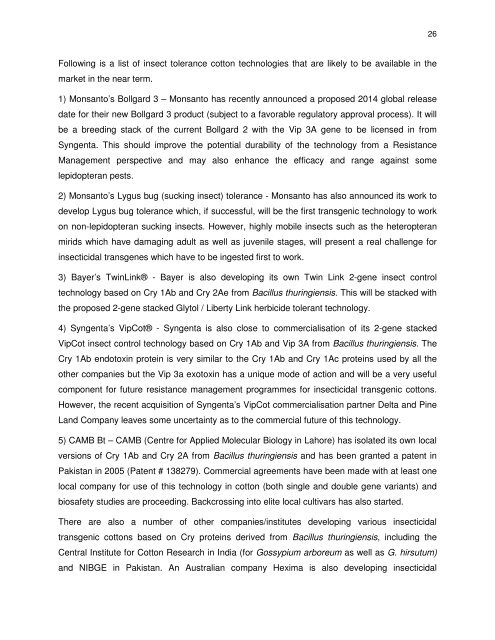ChangingCottonLandscapeNeilForrester
ChangingCottonLandscapeNeilForrester
ChangingCottonLandscapeNeilForrester
Create successful ePaper yourself
Turn your PDF publications into a flip-book with our unique Google optimized e-Paper software.
Following is a list of insect tolerance cotton technologies that are likely to be available in the<br />
market in the near term.<br />
1) Monsanto’s Bollgard 3 – Monsanto has recently announced a proposed 2014 global release<br />
date for their new Bollgard 3 product (subject to a favorable regulatory approval process). It will<br />
be a breeding stack of the current Bollgard 2 with the Vip 3A gene to be licensed in from<br />
Syngenta. This should improve the potential durability of the technology from a Resistance<br />
Management perspective and may also enhance the efficacy and range against some<br />
lepidopteran pests.<br />
2) Monsanto’s Lygus bug (sucking insect) tolerance - Monsanto has also announced its work to<br />
develop Lygus bug tolerance which, if successful, will be the first transgenic technology to work<br />
on non-lepidopteran sucking insects. However, highly mobile insects such as the heteropteran<br />
mirids which have damaging adult as well as juvenile stages, will present a real challenge for<br />
insecticidal transgenes which have to be ingested first to work.<br />
3) Bayer’s TwinLink® - Bayer is also developing its own Twin Link 2-gene insect control<br />
technology based on Cry 1Ab and Cry 2Ae from Bacillus thuringiensis. This will be stacked with<br />
the proposed 2-gene stacked Glytol / Liberty Link herbicide tolerant technology.<br />
4) Syngenta’s VipCot® - Syngenta is also close to commercialisation of its 2-gene stacked<br />
VipCot insect control technology based on Cry 1Ab and Vip 3A from Bacillus thuringiensis. The<br />
Cry 1Ab endotoxin protein is very similar to the Cry 1Ab and Cry 1Ac proteins used by all the<br />
other companies but the Vip 3a exotoxin has a unique mode of action and will be a very useful<br />
component for future resistance management programmes for insecticidal transgenic cottons.<br />
However, the recent acquisition of Syngenta’s VipCot commercialisation partner Delta and Pine<br />
Land Company leaves some uncertainty as to the commercial future of this technology.<br />
5) CAMB Bt – CAMB (Centre for Applied Molecular Biology in Lahore) has isolated its own local<br />
versions of Cry 1Ab and Cry 2A from Bacillus thuringiensis and has been granted a patent in<br />
Pakistan in 2005 (Patent # 138279). Commercial agreements have been made with at least one<br />
local company for use of this technology in cotton (both single and double gene variants) and<br />
biosafety studies are proceeding. Backcrossing into elite local cultivars has also started.<br />
There are also a number of other companies/institutes developing various insecticidal<br />
transgenic cottons based on Cry proteins derived from Bacillus thuringiensis, including the<br />
Central Institute for Cotton Research in India (for Gossypium arboreum as well as G. hirsutum)<br />
and NIBGE in Pakistan. An Australian company Hexima is also developing insecticidal<br />
26


